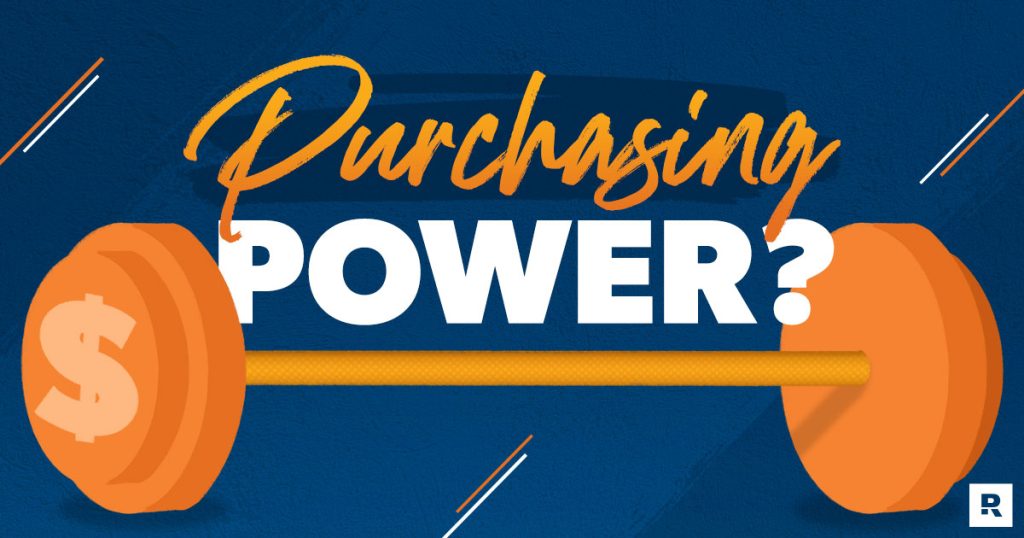If you think purchasing power is just a stuffy vocabulary term from the glossary of your high school economics textbook . . . well, you’re right. But it’s also something that impacts the value of every dollar you have to your name. Which makes it a pretty big deal. And if you really want to understand the “power” of purchasing power, we’ve got to connect all the dots on how things like inflation, deflation and cost of goods impact the economy (and your purchasing power) too. So buckle up, we’re going to walk you through everything you need to know about purchasing power.
What Is Purchasing Power?
Purchasing power boils down to this: It’s how much value your money has. In other words, it’s how many goods and services you can buy with your money. In the U.S. when people say purchasing power, they’re usually talking about how far your dollars go to cover the price of items you want to buy. For example, if you walk into the grocery store, how many things could you buy for 20 bucks? Can you buy four packs of diet Coke or only two? That’s your purchasing power right there.
These days, it’s no secret that a dollar bill has way less purchasing power than it did 50, 20 or even just 10 years ago. According to the Ramsey State of Personal Finance Report, 79% of Americans say their money doesn’t go as far as it used to. And for that, you can thank a little thing called inflation (we’ll get to that later).
What Is Consumer Buying Power?
Consumer buying power is how you (the consumer) decide to spend money. It’s all about your behavior. If you have $500 to spend on items each month, then that’s your consumer buying power—meaning $500 is how much money you’ll put back into the economy when you buy stuff.
Now, look out—it’s easy to get this one confused with purchasing power. And even though they’re related to each other, they’re still different. Consumer buying power is how much money you can personally spend from your wallet, but purchasing power is how far that cash will go.
How Does Purchasing Power Impact the Economy?
You name it—cost of living, price of goods, stocks, inflation, deflation, the economy as a whole. Purchasing Power has its sticky little hands in all parts of the economy. So let’s break down how it affects the economy one fancy vocabulary word at a time.
Inflation
Inflation is basically when the prices of goods and services go up. It’s measured by how much prices inch up over time and tracks how the value of money falls because of those price hikes.
Inflation makes your purchasing power go down by cutting back on the value of your money—aka your dollar doesn’t go as far. And that’s definitely what we’re seeing right now. As of September 2021, the inflation rate in the U.S. had risen to 5.4% over the previous 12 months—that’s up 0.4% from August’s numbers.1
Deflation
Deflation is when the prices for goods and services go down over time and the rate of inflation drops under 0%. In plain words, that just means you can get more bang for your buck (aka purchasing power) when you head out to the store or shop online.
Start budgeting with EveryDollar today!
Cheaper prices might sounds good at first, but don’t be fooled—deflation isn’t a good thing. It creates a whole bunch of new problems to deal with. Deflation can make unemployment rates spike, salary and hourly pay drop, and big-time assets like homes lose their value. And sometimes, it can even spur on a recession. See? Not so great.
Consumer Price Index
The Consumer Price Index (CPI) measures the change in the prices of goods and services that consumers pay over time. In other words, CPI tracks how much your toothpaste costs today compared to three years ago. And in case you’re wondering, the CPI—like most things lately—is going in one direction: up. When that happens, your purchasing power goes in the opposite direction: down.
How to Compare Purchasing Power Between Countries
Let’s say you want to travel to Scotland—awesome! As soon as your plane lands, you start sight-seeing and listening for bagpipes while you travel through the beautiful land. But then the hunger pains hit, and it’s time for some food. How far would a 10 USD bill go when converted to Euros? Can you buy a Big Mac, large fries and soda—or will it only be enough to pay for just your burger? The Purchasing Power Parity (PPP) will show you how it all shakes out.
What Is Purchasing Price Parity? (PPP)
No, it’s not a parody about purchasing things. Purchasing Price Parity (PPP) is the exchange rate that a country uses to convert the currency of another country in order to buy the same amount of goods and services. To put it simply, it just compares the cost of a Big Mac in one country to the cost in another country (after all the exchange rates).
How to Calculate Purchasing Power
If you want find the numbers when it comes to purchasing power, here’s what you do: Just compare the Consumer Price Index from the two years you’re looking at—because the purchasing power change is the same as the Consumer Price Index change.
Then you can use this to figure it out:
Oldest CPI
—————————— x 100 = CPI change
Recent CPI
Let’s use 1988 and 2020 as an example. You’d take 1988’s CPI number (118.3), divide it by 2020’s CPI number (258.8), then multiply it by 100, and you’d get the CPI change of 45%. That means the Consumer Price Index (and your purchasing power) changed 45% from the Rubik’s cube days of 1988 to the year of the great toilet paper hoarding of 2020.
How Does Purchasing Power Impact Your Money?
You feel purchasing power in your daily life when prices and cost of living go up—but it doesn’t just stop there. Purchasing power plays into your future too. Things like savings and investments are all impacted by purchasing power. Let’s look at some of the ways it hits your money:
Spending
One of the biggest ways purchasing power affects you is when you buy everyday items like eggs, milk, bread, toothpaste and clothes. How many times have you gone to pay for something at a store and all of a sudden you thought, Wait, this stuff never used to cost this much. You’re not wrong. Prices are definitely rising. Everything feels more expensive these days—because it is.
The price index for dairy items went up 2.2%, and the price index for beef went up 4.8% since August 2021. The food index overall is still on the rise, clocking it at 4.6% higher than a year ago, and the energy index is—get this—25% higher than a year ago!2 Sheesh. With hikes like that, it’s easy to see how your purchasing power can go way down.
Cost of Living
It’s no secret that cost of living has skyrocketed over the years. Think about how much your grandpa’s salary was in 1965. Now think about the salary you’d have to make today to afford that same kind of life. Let’s hop in a time machine to see a better breakdown of the numbers:
Average annual salary in 1965: $6,9003
Average house price in 1965: $21,5004
Average cost of gasoline in 1965: 30 cents a gallon5
Saving
If the purchasing power of your dollar goes down, that means that the value of the money you’re saving for the future will go down too. Think back to 15 years ago and how good you would feel about saving $500 in your bank account. Having that in your savings used to go pretty far to cover you for an emergency, pay for Christmas, or set you up on a nice vacation. But now? That same $500 in your savings account can still go a long way—but not as far.
Here’s the harsh truth: If purchasing power goes down over time, that means the money you save now won’t go as far in 20 years. Yeah—that’s a bummer all right. But that’s why it’s even more important that you focus on wiping out your debts so you can start saving for the future sooner instead of later. And just because the value of your dollar could go down over time does not—we repeat: does not—mean that you shouldn’t make saving a priority.
Investments
Like we talked about, your purchasing power will most likely go down over time (thanks, inflation). So, when you’re ready to start drawing money from your 401(k) in 30 years, your money probably won’t go as far.
Here’s the good news though (finally!): Investing in good growth stock mutual funds is one of the best things you can do to fight back at inflation and actually give your purchasing power a boost. Let’s say your investments keep growing at an interest rate of 10% for the next 30 years—that 10% in interest can help you offset the rise in inflation. Pretty cool, right?
That’s why you need a pro like one of our SmartVestors in your corner. They can help you make the most out of your investments to give you more bang for your buck later on down the road. Connect with one of our pros today and your future self will be so glad you did. You can’t control how much purchasing power you have in the future, but you can make smart choices now to set yourself up for success.
Read the full article here












